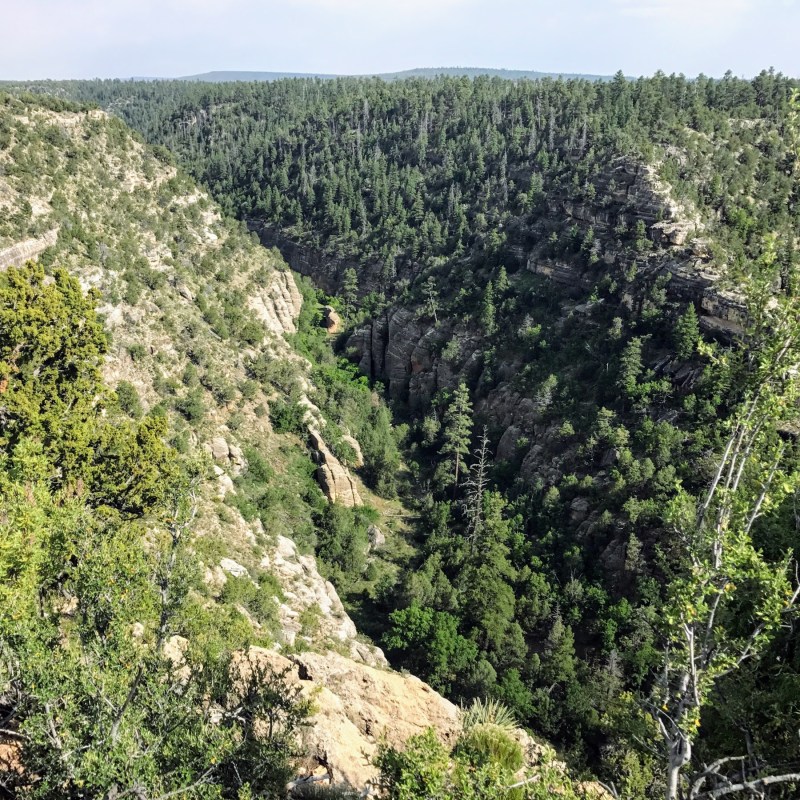
Emese Fromm
One of Arizona’s greatest hidden gems, Walnut Canyon National Monument is a gorgeous display of geological cliff formations with curved limestone walls and ledges filled with a diverse ecosystem. Carved by Walnut Creek over about 60 million years, the canyon offers an amazing combination of stunning scenery and varied animal and plant life.
Videos by TravelAwaits
It also offered a great place to live for the ancient people of the high desert. As gorgeous as the natural scenery of the canyon is, its most interesting features are the cliff dwellings built into the alcoves of the steep canyon walls.
Just outside Flagstaff’s city limits, Walnut Canyon National Monument preserves these cliff dwellings, along with the unusual ecosystem of the canyon, making it a must-see for anyone visiting northern Arizona.
The following are some things you can explore during your visit.

Emese Fromm
1. The Cliff Dwellings Of The Sinagua
About 700 years ago, Walnut Canyon was home to a group of Ancestral Puebloans called the Sinagua, a Spanish term meaning “without water.” The name comes from the name the Spaniards gave the surrounding San Francisco Peaks, the Sierra Sin Agua.
The Sinagua people also built Montezuma Castle, Tuzigoot, and other cliff dwellings and pueblo-style homes in Arizona, but none has the same concentration of well-preserved ruins as Walnut Canyon.
Here, the Sinagua transformed the natural alcoves of the steep canyon walls into unique homes. They used limestone rocks held together by clay to build walls around the alcoves and wooden beams to reinforce the openings for doorways.
Taking the Island Trail will give you the opportunity to visit 25 cliff dwelling rooms built between 1100 and 1250. You’ll walk by them on the trail and might even enter a few. You’ll notice blackened walls and ceilings in a few rooms, a remnant of the Sinagua fires for cooking or warmth.
As you walk along the trail, you’ll see similar cliff dwellings across the canyon in every direction.
The Island Trail is a paved, 1-mile round trip. However, it is steep, and the climb back out might be strenuous, especially for those unaccustomed to exercise at high elevations. You are dealing with 240 stairs leading down 185 vertical feet onto the side of the canyon at 7,000 feet elevation. Take it slow, and make sure you carry plenty of water.
2. The Visitor Center
To learn more about the Sinagua, walk through the Walnut Canyon Visitor Center. Comprehensive exhibits and murals explain what life was like in and around Walnut Canyon for these ancient people who knew how to survive with little water. Though they abandoned their homes inside the canyon, the Sinagua didn’t disappear; they are the ancestors of the Pueblo people of today.
The exhibits include artifacts collected at the site, including an intact clay pitcher with an elaborate black-and-white design and cloth fragments made of yucca and cotton fibers.

Emese Fromm
3. The Pithouses And Freestanding Pueblos
The Sinagua were farmers, growing beans, squash, and corn on the canyon rim. They built one-room pithouses and freestanding pueblos near their farm fields on top of the canyon when they first settled in the area. The remains of many still stand scattered on the canyon rim.
Built partially underground to keep them warm in the winter and cool in the summer, pithouses were common structures in the ancient Southwest. Their stone foundations lasted longer than the higher walls and roofs, usually made of wooden beams and clay.
Stop at the stone foundation of one of the pithouses, protected by a roof built in recent times, to learn about the structure. You’ll also find the remains of a few other structures on the rim top, in the pinion and juniper forest away from the rim. Take a short side trail into the forest from the Rim Trail to access the area.

Emese Fromm
4. The Scenic Views Of The Canyon
Walking along the Rim Trail, you’ll have opportunities to stop for scenic views of Walnut Canyon. From this vantage point, you’ll notice the canyon’s depth of 400 feet and its quarter-mile width. You’ll also see a large number of cliff dwellings scattered on its sides on the limestone ledges.
You’ll also notice the vegetation in the canyon. Walnut Canyon is greener than other canyons in the Southwest and home to several forest habitats. Looking across the canyon, you’ll see ponderosa pines. Farther down, pinyon and juniper forests showcase a lighter green, and if you look toward the bottom, you might glimpse the riparian area where Walnut Creek used to flow.
The Rim Trail is short, paved, and pet-friendly, offering a pleasant walk along the canyon’s rim. It is accessible to the first viewpoint and even farther on with help. Viewfinder telescopes offer a closer look at some of the cliff dwellings.
5. The Variety Of Plant Life
Walnut Canyon has an unusual variety of plant communities, giving you an opportunity to explore species that don’t normally coexist. Miniature versions of all the zones in the western part of the continent, from Mexico to Canada, all exist within this 20-mile-long and 400-foot-deep space.
Descending on the Island Trail, you feel you’re walking from the Upper Sonoran Desert, with yucca and prickly pear cacti, to the cooler, moist forests of the Pacific Northwest, with Douglas firs and shade-tolerant conifers and shrubs.
On the rim, you’ll walk through pinyon-and-juniper forests and ponderosa pines along with the Gambel oaks found through the Southwest. Surrounding Walnut Canyon is the largest ponderosa pine forest on the continent.
Though you can’t walk through it, you might see the bottom from afar. The plant life there is again very different, with a riparian (riverbank) community including aspens, cottonwoods, and black walnuts. Even without water flowing in Walnut Creek, the riverbank vegetation has survived.

Emese Fromm
6. The Wildlife
Spending some quiet time in the forest on the rim gives you the best chance of seeing a variety of wildlife. Watch the ground or the walls of any structure, and you’ll see plenty of lizards sitting in the sun or disappearing into the low vegetation. Ground squirrels and chipmunks are likely to run around the surrounding trees. Blue jays, pinyon jays, and canyon wrens fly around and perch on the branches of the pines. You’ll see mule deer, cottontail rabbits, and jackrabbits as well.
For a relatively small area, Walnut Canyon is home to a wide variety of wildlife. Coyotes, elk, mountain lions, and pronghorn antelope frequent the area, while the south side of the canyon is a habitat for wild turkeys. On a visit, you might glimpse some of these animals, too.
The steep terrain of the canyon offers a habitat for birds of prey, including a few varieties of hawks, the golden eagle, the prairie falcon, and the great horned owl. You might spot some of them if you are there at the right time.

Emese Fromm
7. The Geology
Walking along the Island Trail or the Rim Trail will give you an opportunity to explore the geology of Walnut Canyon, a glimpse into millions of years of Earth’s history. Part of the Colorado Plateau, Walnut Canyon’s walls have three distinct layers. The light-colored Kaibab Limestone forms the upper layer, where the cliff dwellings are. You’ll notice the darker-colored Toroweap Formation on the slopes below. The bottom third of the canyon walls are white Coconino Sandstone.
If you look down into the canyon from one of the Rim Trail overlooks, you’ll notice the horizontal layers of Kaibab Limestone with the alcoves that housed the cliff dwellings. Just below, you’ll see a layer of darker, more eroded slope supporting more vegetation, shrubs, and low trees. The sheer, lighter-colored cliffs of Coconino Sandstone showcase swirls of sand erosion dunes on the bottom third of the canyon.
What To Know Before You Go
Walnut Canyon National Monument is 7.5 miles east of Flagstaff off of Interstate 40, 3 miles down the road from Exit 204. Driving in, look for wildlife in the forest along the road — you are most likely to see mule deer.
In the summer, temperatures exceed the 90s, though between July and September, afternoon thunderstorms are common, and they may come without warning, cooling things down significantly. From late fall through spring, you might encounter snowstorms.
During storms, especially when they involve high winds, park officials might close the Island Trail temporarily for safety. You can still watch the gorgeous scenery in a storm from the large windows of the visitor center or from its covered patio.
